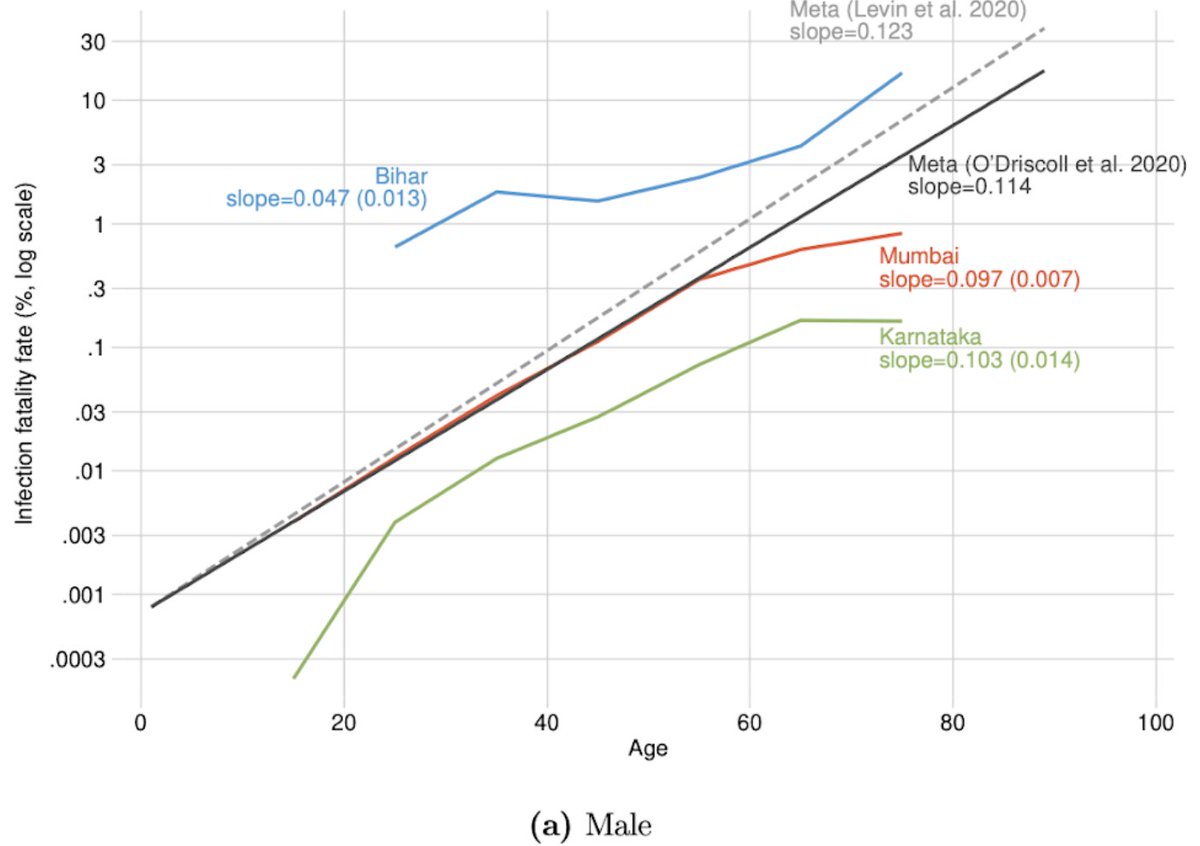I'm excited to see our Karnataka sero-prevalence study out in @JAMA_current today. This is part of a longer chain of surveys we've done to track and understand COVID in India to help policymakers. THREAD https://twitter.com/profmohanan/status/1357419096934023168
It began w/ this study (w @VaidehiTandel) with RT-PCR tests on a random sample of migrants returning to Bihar after lockdown was lifted in May. It found weak correlation b/w a state's reported prevalence & prevalence among migrants from that state. https://www.medrxiv.org/content/10.1101/2020.06.26.20138545v1
Then came this study showing seroprevalence in Mumbai slums (~55%) was 3.5 x that in non-slums (~15%) by July. (Although unpublished, we found similar rates in August.) @IDFCinstitute https://www.thelancet.com/journals/langlo/article/PIIS2214-109X(20)30467-8/fulltext
Related: This BMC study found 75% seroprevalence in slums by October. https://www.indiatoday.in/coronavirus-outbreak/story/serosurvey-mumbai-slum-antibodies-coronavirus-1745303-2020-11-30
The Mumbai study begged the question why slums had such worse outcomes, despite lockdown. With @ashishgoel & one of his students we are examining smartphone location data to see if differential trends in mobility are an explanation. Similar to work by @arpitrage in NYC.
Our Karnataka study published today looked at urban v. rural seroprevalence by August. It found overall seroprevalence in the state of 67m persons was ~46%, and urban areas had rates that were 10 pp greater than rural.
Rural areas are less dense so you'd expect much lower rates. So how did COVID spread so fast there? Maybe migrants spread it when they fled cities. Or rural areas had higher mobility cuz ag was exempt from lockdown (our @medrxivpreprint has evidence on this).
One thing that I found interesting about the Karnataka study is that the sample was from @_CMIE 's Consumer Pyramid's panel. This means we can check if informed consent causes selection bias that affects seroprevalence estimates. We hope to report on this soon...
Another important finding from Karnataka: our survey implied over 30m actual infections -- 96x officially reported cases! How much can we trust daily trends in cases to tell us how we're handling the epidemic if actual cases are nearly 100x greater?
Combined w/ the Bihar results, it stresses the importance of better population surveillance. @ShamikaRavi @muditkapoor & I found that democracies have less COVID data manipulation than authoritarian govts ( https://arxiv.org/abs/2007.09566 ), but that doesn't mean India's data is perfect.
Our seroprevalence from Mumbai implied lower IFR in India. Remarkably we found lower IFR in slums than non-slums! Our Karnataka also implied very low IFR. We combined IFR estimates in this pre-print with @paulnovosad @thesamasher @VaidehiTandel
The main takeaways: 1/ While IFR's are lower, there is a lot of variation across India. Bihar migrant's IFRs are *higher* than in developed countries! 2/ India's elderly have a larger advantage int'l comparisons than its youth!
Combining the old-age results here and the lower IFRs in slums suggests survivorship bias. Another topic we hope to explore soon.
After Karnataka, we ( @VaidehiTandel & @IDFCinstitute) analyzed a large population (N=26,140) sero-survey in Tamil Nadu in November. Pre-print will be up v soon. (Teaser: seroprevalence lower than Karnataka, but a lot of variation across the state. Also, low IFR.)
Our surveys are part of a larger set of studies tracking COVID in India. There are important studies from Delhi, Andhra Pradesh, Pune, Karnataka, and nationally from ICMR. @RameshPV2010 https://www.researchgate.net/publication/346058920_Community_prevalence_of_antibodies_to_SARS-CoV-2_and_correlates_of_protective_immunity_in_five_localities_in_an_Indian_metropolitan_city_SUMMARY_Background
I particularly like this paper in Science that showed that a small number of ppl are responsible for a disproportionate amount of spread in India. https://science.sciencemag.org/content/370/6517/691
There is more to do! Cuz antibodies fade over time, seroprevalence may underestimate population immunity. So @anuacharya is conducting a survey to measure cellular immunity in the field. @r_sabareesh @satejsoman are seeing if there are statistical corrections for this bias.
All of this work is partly motivated by policy. Working with @BettencourtLuis @jonathangruber1 @VaidehiTandel @satejsoman & others we used the analyses above to make recommendations about suppression policy. https://www.nber.org/papers/w27532
Working w @IDFCinstitute we ( @satejsoman @r_sabareesh) use these surveys to help inform vaccine allocation plans in India. Report will be out soon.
After COVID is gone, we will have an economic mess to deal with. @arpitrage & I are looking @_CMIE CPHS data to see how people protected themselves economically and where we stand. Many others, including Kaushik Krishnan, who is on the KA paper, are looking at the path forward.
@profmohanan @BhramarBioStat @UChicagoLaw @HarrisPolicy @nebuer42 @pritika13 @CafeEconomics @NeelanjanSircar @karthik_econ @ATabarrok @tylercowen @srajagopalan

 Read on Twitter
Read on Twitter


